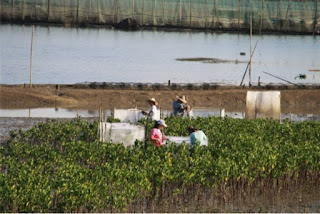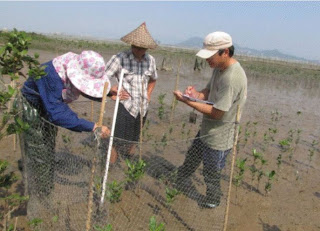Mangrove Planting Research at Eyuyu Island, Fujian Province
China Mangrove Conservation Network (CMCN) is a non-governmental organization which devotes itself to mangrove protection. Founded in 2001, CMCN has successfully united various forces —-mangrove reserves, communities, schools, volunteer groups, NGOs, relative government agencies and mass media—as a network.
Since 2003 CMCN started the mangrove restoration project and relevant basic scientific research programs. So far CMCN has organized or participated in planting activities hundreds of times and has planted more than 900,000 seedlings. During the process of mangrove restoration, CMCN has overcome many technical problems including tree species selection, management and cultivation. Summarizing the experience over the past ten years, CMCN has published a mangrove restoration instruction manual for public participants. However, there are still many challenges confronting mangrove restoration. One of the biggest problems is the barnacle damage to mangrove seedlings after planting (Fig 1). In many places the barnacle damage are so serious they kill the mangrove seedlings. We’ve tried many ways to solve this problem. In 2012, associated with Prof Yihui Zhang of Xiamen University we designed an experiment to try to solve this problem by using a biological control method. We hypothesized that Mud Crab (Scylls serrata) which is an important local economic species preys on barnacles, so we undertook an experiment to verify this by a using net enclosure (fig 2). If Scylls serrata do prey on barnacles, than this will be a win-win solution. The experimental and control groups, both with and without crabs were set-up respectively using three duplicates plots.
The experiment has been underway for 4 months now and it is still in progress so we haven’t obtain any conclusions yet. But through the observations every month, we do find barnacle damage is mitigated in the experimental groups. We are not sure whether the mitigation is due to the mud crabs, because our vidicon camera hasn’t record the process of mud crabs preying on barnacles yet.
If our hypothesis is proved, we will help farmers raise mud crabs in the area where mangroves are planted. One advantage would be the mangrove seedlings will face reduced barnacle damage, and the other benefit is mud crabs can bring good economical benefits for the farmers.
Fig 1. Barnacle damage to mangrove seedlings on Eyuyu Island

Fig 2. Setting-up net enclosure with a cover on the top
During the low tidal ebb, we fixed a water-proof vidicon camera to observe the predation behavior of Scylls serrata (fig 2).

Fig 3. Fixing a water-proof vidicon camera on the net enclosure
In the early stage after planting, the mangrove seedlings are also prone to damage by other animals like rats, mice, crabs and so on. We also designed an experiment to test the impact of animals on the growth of mangrove seedlings.

Fig 4. Securing net enclosure, with small mesh holes, which will prevent all types of animals from entering.
Fig 5. Securing net enclosure with large holes to prevent larger animals, such as rodents, from entering.
In 2009, CMCN introduced mangrove working holidays on Eyuyu Island, off Xiamen in Fujian province with the main activities including collecting, culturing and planting seedlings. At the same time the working holidays infused outdoor experience in nature along with the cultural community experience, thereby raising the awareness of participants.
Fig 6. Environmental Education experience during a working holiday
Contract:
Gao Xuequin
China Mangrove Conservation Network (CMCN)
Xiamen University, Xiamen, Juijan, China
http://www.china-mangrove.org/



